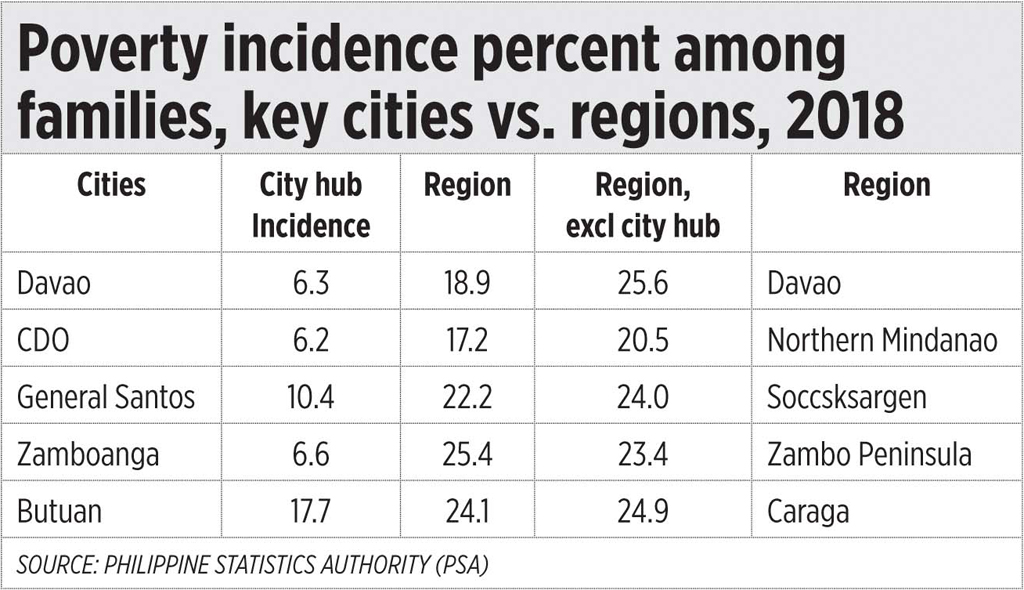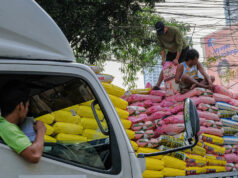The poverty incidence among families declined to 12.1% in 2018 from 17.9% in 2015. This is unprecedented. In 2009, the incidence was 20.5% according to the Philippine Statistics Authority (PSA).
In the case of Mindanao, the gap between the poverty incidence of city hubs with the whole region is expected but is a cause of concern. The city incidences were mostly in single digits but those of the region, three times on the average. Interestingly, the region-city gaps are mainly on the “tens.”
A city has lower poverty due to the presence of trade and distribution centers, access to ports and airports, and government offices. These provide steady employment for workers. The situation is in stark contrast with rural towns where employment is generally low wage and seasonal.
Most rural regions are heavily dependent on agriculture. In Mindanao, the main agricultural commodity bases are:
• Davao: coconut products, cavendish banana, cacao, coffee
• Northern Mindanao: coconut products, pineapple, sugar, corn, banana
• Soccsksargen: coconut, palay, corn, pineapple, rubber, coffee, oil palm, banana
• Zamboanga: coconut, rubber, sardine fishery
• Caraga: coconut
Industrial plants exist in Davao, Northern Mindanao, and Soccsksargen. These include firms in cement, coconut oil mills, industrial bakeries, breweries, packaging products, and rebar mills.
While regions like Soccsksargen have diversified, its regional poverty appears high compared to less diversified Davao region.
Low productivity and undeveloped value chains are among the causes:
• Davao: Coconut products and banana are the main agri exports. There are nuances. Coconut is small-holder and a low-yield crop. Thus, the full value chain cannot be realized due to lack of scale. There is a large multi-product exporter (i.e., Franklin Baker) but it also faces quality raw material shortages.
• Cavendish banana has value chain integration and generates high-value and full-time jobs.
• By contrast, Northern Mindanao has full-value chain for pineapple. It hosts Axelum Resources, a large exporter of multi-product coconut lines, and Del Monte.
• Soccsksargen hosts several integrated chains: Century Pacific (multiproduct exporter), Dole Philippines, and several tuna canners. All are exporters.
The “classic” paradigm persists — low farm productivity, low investment, underdeveloped agro-industry, and, consequently, low employment creation and competitiveness.
INTERNATIONAL EVIDENCE
A study done by Ferre, Ferrera, and Lanjou in 2012 provides evidence of an inverse relationship between poverty and city size. Poverty is both more widespread and deeper in small towns than in large cities.
The authors found out that for all eight countries studied, most of the urban poor live in medium, small or very small towns. Moreover, it is shown that the greater incidence and severity of poverty in smaller towns is generally compounded by similarly greater deprivation in terms of access to basic infrastructure services, such as electricity.
What do these tell us?
The regional poverty, net of the city hub, has uncanny similarities across regions, some 8% on the average. The poverty incidence outside the city hubs averages 24%. Rural poverty incidence appears consistent across regions.
Low productivity and lack of non-farm income opportunities hound the agricultural regions. Breaking the barriers of rural poverty is a long-term process. The rural sector is in dire need of research and extension services. A key strategic action is to encourage private investments by lifting the agrarian reform law’s five-hectare retention limit. Farm consolidation will likely benefit low-yield smallholder areas with economies of scale.
The urban-rural gap reflects a development pattern. The challenge for the government is how soon the gap can be narrowed.
Suggested reading: “Asia’s rural-urban disparity in the context of growing inequality” by Katsushi S. Imai Bilal Malaeb, IFAD Research Series No. 27 (2018).
This article reflects the personal opinion of the author and does not reflect the official stand of the Management Association of the Philippines or the MAP.
Rolando T. Dy is the Co-Vice Chair of the MAP AgriBusiness Committee, and the Executive Director of the Center for Food and AgriBusiness of the University of Asia & the Pacific.




